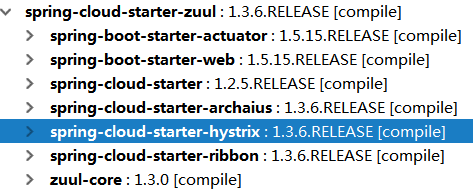【SpringCloud】Zuul在何種情況下使用Hystrix
首先,引入spring-cloud-starter-zuul之後會間接引入:

hystrix依賴已經引入,那麼何種情況下使用hystrix呢?
在Zuul的自動配置類ZuulServerAutoConfiguration和ZuulProxyAutoConfiguration中總共會向Spring容器注入3個Zuul的RouteFilter,分別是
SimpleHostRoutingFilter
簡單路由,通過HttpClient向預定的URL傳送請求
生效條件:
RequestContext.getCurrentContext().getRouteHost() != null
&& RequestContext.getCurrentContext().sendZuulResponse()1、RequestContext中的routeHost不為空,routeHost就是URL,即使用URL直連
2、RequestContext中的sendZuulResponse為true,即是否將response傳送給客戶端,預設為true
RibbonRoutingFilter
使用Ribbon、Hystrix和可插入的http客戶端傳送請求
生效條件:
(RequestContext.getRouteHost() == null && RequestContext.get(SERVICE_ID_KEY) != null
&& RequestContext.sendZuulResponse())1、RequestContext中的routeHost為空,即URL為空
2、RequestContext中的serviceId不為空
3、RequestContext中的sendZuulResponse為true,即是否將response傳送給客戶端,預設為true
SendForwardFilter
forward到本地URL
生效條件:
RequestContext.containsKey(FORWARD_TO_KEY)
&& !RequestContext.getBoolean(SEND_FORWARD_FILTER_RAN, false)1、RequestContext中包含FORWARD_TO_KEY,即URL使用 forward: 對映
2、RequestContext中SEND_FORWARD_FILTER_RAN為false,SEND_FORWARD_FILTER_RAN意為“send forward是否執行過了”,在SendForwardFilter#run()時會
ctx.set(SEND_FORWARD_FILTER_RAN, true)
綜上所述,在使用serviceId對映的方法路由轉發的時候,會使用Ribbon+Hystrix
而哪種路由配置方式是“URL對映”,哪種配置方式又是“serviceId對映”呢?
Zuul有一個前置過濾器PreDecorationFilter用於通過RouteLocator路由定位器決定在何時以何種方式路由轉發
RouteLocator是用於通過請求地址匹配到Route路由的,之後PreDecorationFilter再通過Route資訊設定RequestContext上下文,決定後續使用哪個RouteFilter做路由轉發
所以就引出以下問題:
- 什麼是Route
- RouteLocator路由定位器如何根據請求路徑匹配路由
- 匹配到路由後,PreDecorationFilter如何設定RequestContext請求上下文
什麼是Route
我總共見到兩個和Route相關的類
ZuulProperties.ZuulRoute,用於和zuul配置檔案關聯,儲存相關資訊
org.springframework.cloud.netflix.zuul.filters.Route, RouteLocator找到的路由資訊就是這個類,用於路由轉發
public static class ZuulRoute {
private String id; //ZuulRoute的id
private String path; //路由的pattern,如 /foo/**
private String serviceId; //要對映到此路由的服務id
private String url; //要對映到路由的完整物理URL
private boolean stripPrefix = true; //用於確定在轉發之前是否應剝離此路由字首的標誌位
private Boolean retryable; //此路由是否可以重試,通常重試需要serviceId和ribbon
private Set<String> sensitiveHeaders = new LinkedHashSet(); //不會傳遞給下游請求的敏感標頭列表
private boolean customSensitiveHeaders = false; //是否自定義了敏感頭列表
}public class Route {
private String id;
private String fullPath;
private String path;
private String location; //可能是 url 或 serviceId
private String prefix;
private Boolean retryable;
private Set<String> sensitiveHeaders = new LinkedHashSet<>();
private boolean customSensitiveHeaders;
}可以看到org.springframework.cloud.netflix.zuul.filters.Route和ZuulProperties.ZuulRoute基本一致,只是Route用於路由轉發定位的屬性location根據不同的情況,可能是一個具體的URL,可能是一個serviceId
RouteLocator路由定位器如何根據請求路徑匹配路由
Zuul在自動配置載入時注入了2個RouteLocator
- CompositeRouteLocator: 組合的RouteLocator,在
getMatchingRoute()時會依次呼叫其它的RouteLocator,先找到先返回;CompositeRouteLocator的routeLocators集合中只有DiscoveryClientRouteLocator - DiscoveryClientRouteLocator: 可以將靜態的、已配置的路由與來自DiscoveryClient服務發現的路由組合在一起,來自DiscoveryClient的路由優先;SimpleRouteLocator的子類(SimpleRouteLocator 基於載入到
ZuulProperties中的配置定位Route路由資訊)
其中CompositeRouteLocator是 @Primary 的,它是組合多個RouteLocator的Locator,其getMatchingRoute()方法會分別呼叫其它所有RouteLocator的getMatchingRoute()方法,通過請求路徑匹配路由資訊,只要匹配到了就馬上返回
預設CompositeRouteLocator混合路由定位器的routeLocators只有一個DiscoveryClientRouteLocator,故只需分析DiscoveryClientRouteLocator#getMatchingRoute(path)
//----------DiscoveryClientRouteLocator是SimpleRouteLocator子類,其實是呼叫的SimpleRouteLocator##getMatchingRoute(path)
@Override
public Route getMatchingRoute(final String path) {
return getSimpleMatchingRoute(path);
}
protected Route getSimpleMatchingRoute(final String path) {
if (log.isDebugEnabled()) {
log.debug("Finding route for path: " + path);
}
// routes是儲存路由資訊的map,如果此時還未載入,呼叫locateRoutes()
if (this.routes.get() == null) {
this.routes.set(locateRoutes());
}
if (log.isDebugEnabled()) {
log.debug("servletPath=" + this.dispatcherServletPath);
log.debug("zuulServletPath=" + this.zuulServletPath);
log.debug("RequestUtils.isDispatcherServletRequest()="
+ RequestUtils.isDispatcherServletRequest());
log.debug("RequestUtils.isZuulServletRequest()="
+ RequestUtils.isZuulServletRequest());
}
/**
* 下面的方法主要是先對path做微調
* 再根據path到routes中匹配到ZuulRoute
* 最後根據 ZuulRoute 和 adjustedPath 生成 Route
*/
String adjustedPath = adjustPath(path);
ZuulRoute route = getZuulRoute(adjustedPath);
return getRoute(route, adjustedPath);
}
下面我們來看看locateRoutes()是如何載入靜態的、已配置的路由與來自DiscoveryClient服務發現的路由的
//----------DiscoveryClientRouteLocator#locateRoutes() 服務發現路由定位器的locateRoutes()
@Override
protected LinkedHashMap<String, ZuulRoute> locateRoutes() {
//儲存ZuulRoute的LinkedHashMap
LinkedHashMap<String, ZuulRoute> routesMap = new LinkedHashMap<String, ZuulRoute>();
//呼叫父類SimpleRouteLocator#locateRoutes()
//載入ZuulProperties中的所有配置檔案中的路由資訊
routesMap.putAll(super.locateRoutes());
//如果服務發現客戶端discovery存在
if (this.discovery != null) {
//將routesMap已經存在的配置檔案中的ZuulRoute放入staticServices<serviceId, ZuulRoute>
Map<String, ZuulRoute> staticServices = new LinkedHashMap<String, ZuulRoute>();
for (ZuulRoute route : routesMap.values()) {
String serviceId = route.getServiceId();
//如果serviceId為null,以id作為serviceId,此情況適合 zuul.routes.xxxx=/xxxx/** 的情況
if (serviceId == null) {
serviceId = route.getId();
}
if (serviceId != null) {
staticServices.put(serviceId, route);
}
}
// Add routes for discovery services by default
List<String> services = this.discovery.getServices(); //到註冊中心找到所有service
String[] ignored = this.properties.getIgnoredServices()
.toArray(new String[0]);
//遍歷services
for (String serviceId : services) {
// Ignore specifically ignored services and those that were manually
// configured
String key = "/" + mapRouteToService(serviceId) + "/**";
//如果註冊中心的serviceId在staticServices集合中,並且此路由沒有配置URL
//那麼,更新路由的location為serviceId
if (staticServices.containsKey(serviceId)
&& staticServices.get(serviceId).getUrl() == null) {
// Explicitly configured with no URL, cannot be ignored
// all static routes are already in routesMap
// Update location using serviceId if location is null
ZuulRoute staticRoute = staticServices.get(serviceId);
if (!StringUtils.hasText(staticRoute.getLocation())) {
staticRoute.setLocation(serviceId);
}
}
//如果註冊中心的serviceId不在忽略範圍內,且routesMap中還沒有包含,新增到routesMap
if (!PatternMatchUtils.simpleMatch(ignored, serviceId)
&& !routesMap.containsKey(key)) {
// Not ignored
routesMap.put(key, new ZuulRoute(key, serviceId));
}
}
}
// 如果routesMap中有 /** 的預設路由配置
if (routesMap.get(DEFAULT_ROUTE) != null) {
ZuulRoute defaultRoute = routesMap.get(DEFAULT_ROUTE);
// Move the defaultServiceId to the end
routesMap.remove(DEFAULT_ROUTE);
routesMap.put(DEFAULT_ROUTE, defaultRoute);
}
//將routesMap中的資料微調後,放到values<String, ZuulRoute>,返回
LinkedHashMap<String, ZuulRoute> values = new LinkedHashMap<>();
for (Entry<String, ZuulRoute> entry : routesMap.entrySet()) {
String path = entry.getKey();
// Prepend with slash if not already present.
if (!path.startsWith("/")) {
path = "/" + path;
}
if (StringUtils.hasText(this.properties.getPrefix())) {
path = this.properties.getPrefix() + path;
if (!path.startsWith("/")) {
path = "/" + path;
}
}
values.put(path, entry.getValue());
}
return values;
}此方法執行後就已經載入了配置檔案中所有路由資訊,以及註冊中心中的服務路由資訊,有的通過URL路由,有的通過serviceId路由
只需根據本次請求的requestURI與 路由的pattern匹配找到對應的路由
匹配到路由後,PreDecorationFilter如何設定RequestContext請求上下文
//----------PreDecorationFilter前置過濾器
@Override
public Object run() {
RequestContext ctx = RequestContext.getCurrentContext();
final String requestURI = this.urlPathHelper.getPathWithinApplication(ctx.getRequest());
Route route = this.routeLocator.getMatchingRoute(requestURI); //找到匹配的路由
//----------------到上面為止是已經分析過的,根據requestURI找到匹配的Route資訊
// ==== 匹配到路由資訊
if (route != null) {
String location = route.getLocation();
if (location != null) {
ctx.put(REQUEST_URI_KEY, route.getPath());//RequestContext設定 requestURI:路由的pattern路徑
ctx.put(PROXY_KEY, route.getId());//RequestContext設定 proxy:路由id
//設定需要忽略的敏感頭資訊,要麼用全域性預設的,要麼用路由自定義的
if (!route.isCustomSensitiveHeaders()) {
this.proxyRequestHelper
.addIgnoredHeaders(this.properties.getSensitiveHeaders().toArray(new String[0]));
}
else {
this.proxyRequestHelper.addIgnoredHeaders(route.getSensitiveHeaders().toArray(new String[0]));
}
//設定重試資訊
if (route.getRetryable() != null) {
ctx.put(RETRYABLE_KEY, route.getRetryable());
}
//如果location是 http/https開頭的,RequestContext設定 routeHost:URL
//如果location是 forward:開頭的,RequestContext設定 forward資訊、routeHost:null
//其它 RequestContext設定 serviceId、routeHost:null、X-Zuul-ServiceId
if (location.startsWith(HTTP_SCHEME+":") || location.startsWith(HTTPS_SCHEME+":")) {
ctx.setRouteHost(getUrl(location));
ctx.addOriginResponseHeader(SERVICE_HEADER, location);
}
else if (location.startsWith(FORWARD_LOCATION_PREFIX)) {
ctx.set(FORWARD_TO_KEY,
StringUtils.cleanPath(location.substring(FORWARD_LOCATION_PREFIX.length()) + route.getPath()));
ctx.setRouteHost(null);
return null;
}
else {
// set serviceId for use in filters.route.RibbonRequest
ctx.set(SERVICE_ID_KEY, location);
ctx.setRouteHost(null);
ctx.addOriginResponseHeader(SERVICE_ID_HEADER, location);
}
//是否新增代理頭資訊 X-Forwarded-For
if (this.properties.isAddProxyHeaders()) {
addProxyHeaders(ctx, route);
String xforwardedfor = ctx.getRequest().getHeader(X_FORWARDED_FOR_HEADER);
String remoteAddr = ctx.getRequest().getRemoteAddr();
if (xforwardedfor == null) {
xforwardedfor = remoteAddr;
}
else if (!xforwardedfor.contains(remoteAddr)) { // Prevent duplicates
xforwardedfor += ", " + remoteAddr;
}
ctx.addZuulRequestHeader(X_FORWARDED_FOR_HEADER, xforwardedfor);
}
//是否新增Host頭資訊
if (this.properties.isAddHostHeader()) {
ctx.addZuulRequestHeader(HttpHeaders.HOST, toHostHeader(ctx.getRequest()));
}
}
}
// ==== 沒有匹配到路由資訊
else {
log.warn("No route found for uri: " + requestURI);
String fallBackUri = requestURI;
String fallbackPrefix = this.dispatcherServletPath; // default fallback
// servlet is
// DispatcherServlet
if (RequestUtils.isZuulServletRequest()) {
// remove the Zuul servletPath from the requestUri
log.debug("zuulServletPath=" + this.properties.getServletPath());
fallBackUri = fallBackUri.replaceFirst(this.properties.getServletPath(), "");
log.debug("Replaced Zuul servlet path:" + fallBackUri);
}
else {
// remove the DispatcherServlet servletPath from the requestUri
log.debug("dispatcherServletPath=" + this.dispatcherServletPath);
fallBackUri = fallBackUri.replaceFirst(this.dispatcherServletPath, "");
log.debug("Replaced DispatcherServlet servlet path:" + fallBackUri);
}
if (!fallBackUri.startsWith("/")) {
fallBackUri = "/" + fallBackUri;
}
String forwardURI = fallbackPrefix + fallBackUri;
forwardURI = forwardURI.replaceAll("//", "/");
ctx.set(FORWARD_TO_KEY, forwardURI);
}
return null;
}總結:
- 只要引入了spring-cloud-starter-zuul就會間接引入Ribbon、Hystrix
- 路由資訊可能是從配置檔案中載入的,也可能是通過DiscoveryClient從註冊中心載入的
- zuul是通過前置過濾器PreDecorationFilter找到與當前requestURI匹配的路由資訊,並在RequestContext中設定相關屬性的,後續的Route Filter會根據RequestContext中的這些屬性判斷如何路由轉發
- Route Filter主要使用 SimpleHostRoutingFilter 和 RibbonRoutingFilter
- 當RequestContext請求上下文中存在routeHost,即URL直連資訊時,使用SimpleHostRoutingFilter簡單Host路由
- 當RequestContext請求上下文中存在serviceId,即服務id時(可能會與註冊中心關聯獲取服務列表,或者讀取配置檔案中serviceId.ribbon.listOfServers的服務列表),使用RibbonRoutingFilter,會使用Ribbon、Hystrix
